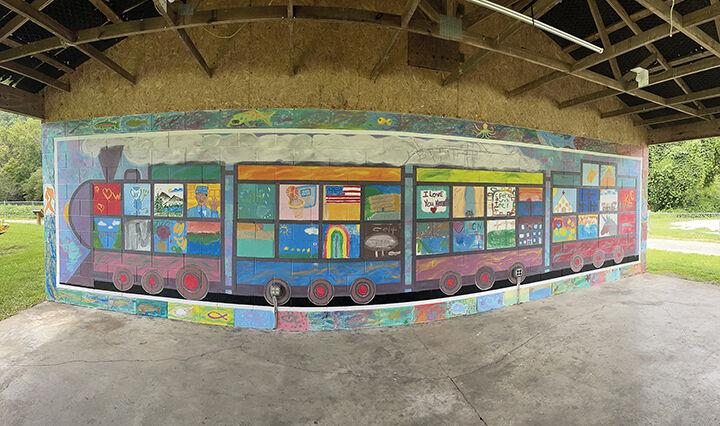Grant provides funding for public mural project at Kermit
- sinaya77
- Jul 2, 2023
- 4 min read
Bruce Justice (Mingo Messenger) Aug 19, 2022

Kermit’s residents are typically unapologetic when it comes to taking a great deal of pride in telling the story behind the town’s founding, its unique history and its individualized culture.
Thanks to a grant provided by the Davis Peace Project, going forward, a solely verbal expression of this exceptional history and culture won’t necessarily be the only way for those living outside Kermit to learn at least some about the town.
Learning what Kermit’s old high school looked like, for example, or getting a quick reference about the two state basketball championships the school brought home to Mingo County in 1964 and 1975, will now be pictorially learned by the everyday onlooker as well.
That’s because these and other stories can now also be visually experienced at the town’s park through a multi-colored mural consisting greatly of distinctive, self-identifying images.
The images collectively make up a larger profile of another integral part of Kermit’s history—the train, which altogether sprawls across a wall of the community park pavilion.
Mingo County Redevelopment Authority Executive Director Leasha Johnson said two college students and friends—Lis Fundberg of Bard College and Claudia Bonaccorsi of Dickenson College, obtained the grant for this particular mural.
Johnson said Fundberg had spearheaded a similar community involvement mural for Sprouting Farms last summer.
Because of Sprouting Farms’ relationship to the Turnrow Appalachia Farm Collective, which Johnson said itself is funded by grant money and is charged with creating a network of grower and producers in southern West Virginia, Fundberg wanted to do other community mural projects across the Turnrow footprint.
“The name of her grant application was called ‘Tracking the Turnrow Network: Appalachia Rising,’ which I thought was really neat,” Johnson said. “At this point the Sprouting Farms people referred her to me because they are our operating partner at Blue Acre Aquaponics and they felt the MCRA could better facilitate the project here in Mingo County.”
Johnson said Funberg and Bonaccorsi were not particularly interested in the aquaponics facility per se as a site, even though it is closely associated with Turnrow through Sprouting Farms.
She said they instead expressed more interest in doing the third of their four 2022 Turnrow public mural projects in a specific Mingo County community.
Following additional discussion, Johnson said, the consensus agreement was that Kermit would be an ideal fit for the grant criteria as well as an ideal location for the project.
Not only has Kermit historically always shown a willingness to be a part of projects of this type, but also an added bonus was the town happens to be the site of the aquaponics facility, Johnson said.
“They wanted it to be a community project rather than a one-artist project similar to the ones that had been done in Williamson,” she said. “They said the mural would be gridded and they would ask members of the community to paint the individual grids … and they asked if I would approach the town about the project.
“I asked Mayor (Charles) Sparks if there was a good place for it in Kermit,” Johnson continued.” and he said the community park pavilion would be the perfect place for it, so from there the project just took off.”
Sparks said both he and the town immediately embraced the project.
“Everyone thought it was a really terrific idea, and we all were very pleased they chose Kermit for the project,” Sparks said.
Following a community meeting to get ideas as to what subject matter the mural should contain, Sparks said most of the grid items were subsequently decided upon and the project began a short time later.
Because their grant funds were limited, and because they would have to live somewhere close by for the two weeks while the mural was being completed, one problem the two students had but one that was quickly remedied was getting affordable housing accommodations.
“Leasha asked if I thought the Big Laurel Learning Center would be able to house them for not a lot of money and I told her that it might be better for me to check first with Marlene Spaulding (Executive Director of A. B. L. E. Families) to see if she might be able to put them up for the time they were going to be here,” Sparks said. “Marlene said they could stay there, and instead of having to pay any kind of rent they simply gave A.B.L.E. Families a love offering.”
While Johnson admits that at least she was at first a little apprehensive about the project, particularly since a few of the community members painting the individual sections would be young kids, she ultimately decided her apprehension had been misplaced.
“I was just so pleased how it turned out,” she said. “The girls stayed very engaged and made sure the quality of each grid was good. And that’s exactly how the final product looked when it was completed two weeks later.”
Sparks said he was also pleased with the final product.
“I’m really proud of the way it turned out,” he said. “And I really can’t express enough just how grateful I am to everyone who had a part in it.”
Facebook
Twitter
Email
Print
Copy article link
Save





































Comments